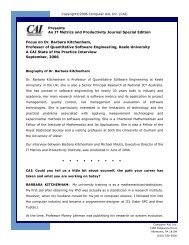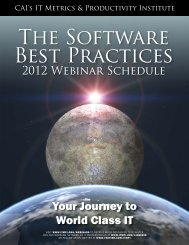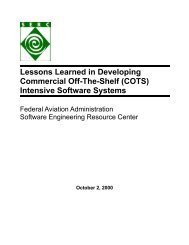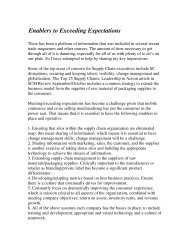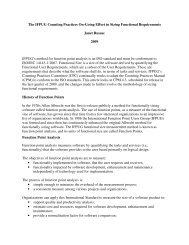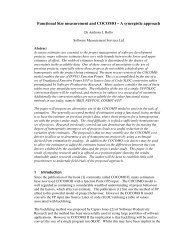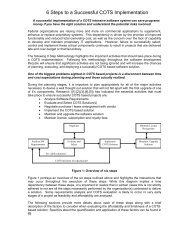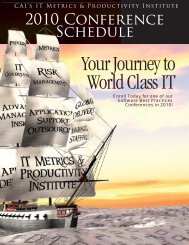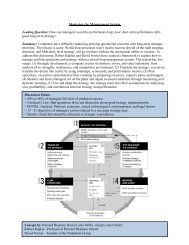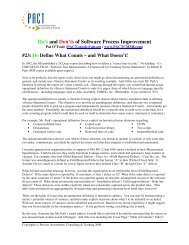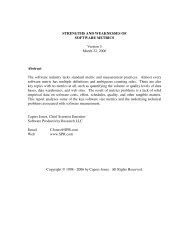Abstract: Offshore Outsourcing has become an IT imperative. This ...
Abstract: Offshore Outsourcing has become an IT imperative. This ...
Abstract: Offshore Outsourcing has become an IT imperative. This ...
You also want an ePaper? Increase the reach of your titles
YUMPU automatically turns print PDFs into web optimized ePapers that Google loves.
<strong>Abstract</strong>:<strong>Offshore</strong> <strong>Outsourcing</strong> <strong>has</strong> <strong>become</strong> <strong>an</strong> <strong>IT</strong> <strong>imperative</strong>. <strong>This</strong> article outlines the key factorsunderlying the successful offshore outsourcing of software development. Topics ofdiscussion include typical pitfalls <strong>an</strong>d how to avoid them, offshore vendor evaluation <strong>an</strong>dm<strong>an</strong>agement, establishing realistic fin<strong>an</strong>cial goals, security <strong>an</strong>d risk m<strong>an</strong>agement, <strong>an</strong>dfinally, navigating the difficult waters of employee impact. <strong>This</strong> article is based upon theh<strong>an</strong>ds-on guide, M<strong>an</strong>aging Software Development <strong>Offshore</strong> - Making it Work (CRCPress, 2004), by the same author.Part One2
Introduction:<strong>Offshore</strong> <strong>Outsourcing</strong> is now widely acknowledged as a core competency for Fortune100 <strong>IT</strong> org<strong>an</strong>izations. <strong>This</strong> article explores the typical pitfalls associated with thesuccessful m<strong>an</strong>agement of software development via <strong>Offshore</strong> <strong>Outsourcing</strong>.The following questions are addressed:• What is <strong>Offshore</strong> or <strong>Offshore</strong> <strong>Outsourcing</strong>?• Why is it <strong>an</strong> <strong>IT</strong> Imperative?• How do we best start our <strong>Offshore</strong> program?• What c<strong>an</strong> we expect in terms of cost savings?• How do we avoid the typical pitfalls of <strong>Offshore</strong> <strong>Outsourcing</strong>?• How do we select the best <strong>Offshore</strong> vendors?• How do we respond to security <strong>an</strong>d geopolitical risk?• What is the best way to h<strong>an</strong>dle sensitive employee concerns?Geared towards the h<strong>an</strong>ds-on <strong>IT</strong> practitioner, the focus of this article is to provide apragmatic guide to <strong>Offshore</strong> software execution, tapping the collective knowledge of"been there - done that" seasoned professionals. For a more extensive treatment of thistopic, interested readers are referred to the h<strong>an</strong>ds-on guide, M<strong>an</strong>aging SoftwareDevelopment <strong>Offshore</strong> - Making it Work (CRC Press, 2004), by the same author.3
It is useful to compare how <strong>Offshore</strong> <strong>Outsourcing</strong> differs from Traditional <strong>Outsourcing</strong>.Traditional <strong>Outsourcing</strong> occurs when the entire <strong>IT</strong> function is shifted to <strong>an</strong> externalorg<strong>an</strong>ization. Traditional <strong>Outsourcing</strong> tends to extract a big price - the loss of thecollaborative partnership between business <strong>an</strong>d technology. <strong>This</strong> critical strategicrelationship often goes by the wayside in the focus to achieve short-term efficiencies <strong>an</strong>dcost cutting. The business - technology partnership is a delicate one, often hard toachieve <strong>an</strong>d maintain. One characteristic of market leaders is that these two majordisciplines are not only able to communicate effectively, but are able to somehowtr<strong>an</strong>smute their mutual underst<strong>an</strong>ding into a strategic adv<strong>an</strong>tage by b<strong>an</strong>ding together todecide how to leverage technology to establish a competitive edge. Few largeTraditional <strong>Outsourcing</strong> firms c<strong>an</strong> afford to have <strong>an</strong> <strong>IT</strong> strategic pl<strong>an</strong>ner follow theircustomer's business leaders around just to tee up next year’s potential partnership – yetthis is exactly what is required when business <strong>an</strong>d technology meet to put a pl<strong>an</strong>together. If the <strong>IT</strong> function is kept in house, the best <strong>an</strong>d brightest of <strong>IT</strong> leadership havelearned to do double duty by keeping a close relationship with their business peers whilesimult<strong>an</strong>eously leading the tactical execution of the existing <strong>IT</strong> strategy. While this mayor may not be acknowledged, even with the growing number of executive level“relationship m<strong>an</strong>agers” that are springing up as part of <strong>IT</strong> services everywhere, it one ofthe key factors that enable truly innovative technology deployment as the basis formarket leadership.<strong>Offshore</strong> <strong>Outsourcing</strong> is unique in that the strategic in-house business partnershipfunction is preserved along with the savings associated with <strong>Outsourcing</strong>. <strong>This</strong> is througha business model commonly called Co-Sourcing.5
In Co-Sourcing, the geographic placement of team members is determined by theirfunction. <strong>Offshore</strong> teams are often discussed in terms of percentages, such as “80/20” or“70/30.” 80/20 me<strong>an</strong>s that, of a given <strong>IT</strong> application development or mainten<strong>an</strong>cesupport team implemented with the Co-Sourcing model, 80% of the team is located<strong>Offshore</strong> (out of the US) <strong>an</strong>d 20% of the team Onshore (within the US or the Americas).<strong>This</strong> team structure is maintained, of course, with “70/30” or even “60/40” teams.Whatever the percentage of the team that is Onshore, the functions of that team usuallyinclude maintaining the partnership <strong>an</strong>d pl<strong>an</strong>ning function with their businesscounterparts. While the specifics vary from team to team <strong>an</strong>d firm to firm, as a generalrule of thumb, the Onshore positions maintain the strategic, pl<strong>an</strong>ning or architecturalfunctions, while the <strong>Offshore</strong> positions usually require the most tactical execution. Thetable below shows the typical Onshore / <strong>Offshore</strong> mix of team functions across thesystems development life cycle (Table A).Part of the Onshore function is the “retained layer” or the internal senior operationalteam responsible for on-going <strong>Offshore</strong> program execution <strong>an</strong>d oversight. <strong>This</strong> internaloversight team provides a focal point for program oversight <strong>an</strong>d reporting. The retainedlayer also ensures that the <strong>Offshore</strong> program remains aligned with the strategic businessgoals of the firm, <strong>an</strong>d that internal stakeholder expectations are both clearly established<strong>an</strong>d monitored for successful execution.6
<strong>IT</strong> Lifecycle StagePrimarilyOnshorePrimarily<strong>Offshore</strong>EquallyOnshore <strong>an</strong>d<strong>Offshore</strong>Business PartnershipXOverall <strong>IT</strong> StrategyXApplication Pl<strong>an</strong>ning <strong>an</strong>d DesignXBusiness Process Pl<strong>an</strong>ning <strong>an</strong>d DesignXApplication Analysis <strong>an</strong>d DesignXApplication Efficiency Analysis /UpgradesXApplication CodingXApplication TestingXApplication Mainten<strong>an</strong>ceXApplication Retirement Pl<strong>an</strong>ningXTable A: Typical <strong>IT</strong> Application Development Team Functional DistributionB. Why is <strong>Offshore</strong> <strong>Outsourcing</strong> <strong>an</strong> <strong>IT</strong> Imperative?Signific<strong>an</strong>t cost savingsMost <strong>Offshore</strong> <strong>Outsourcing</strong> programs demonstrate <strong>an</strong> Internal Rate of Return (IRR) wellover 100%. 2 <strong>IT</strong> projects are routinely approved with <strong>an</strong> IRR well under 70%. Thesavings generated by <strong>Offshore</strong> are difficult to match with other initiatives.2 Independently verified IRR examples are rare. <strong>IT</strong> services 3-year IRR of 272% was independentlyvalidated by Nucleus Research, Inc. in the ROI Case Study: ePeople Teamwork Anonymous case study(www.NucleusResearch.com).7
In mature org<strong>an</strong>izations where <strong>Offshore</strong> <strong>Outsourcing</strong> is well understood across theorg<strong>an</strong>ization, it is often credited with saving the jobs of the <strong>IT</strong> employees from the moredrastic Traditional <strong>IT</strong> <strong>Outsourcing</strong>. So it may well be viewed as <strong>an</strong> integral part ofkeeping the <strong>IT</strong> org<strong>an</strong>ization intact.As <strong>Offshore</strong> <strong>Outsourcing</strong> <strong>become</strong>s more <strong>an</strong>d more part of the mainstream, UScorporations will not be able to afford to keep the <strong>Offshore</strong> appropriate jobs here in theUS, when these services are available at such inexpensive <strong>an</strong>d high quality elsewhere.The l<strong>an</strong>dscape of <strong>Offshore</strong> sets the waves of ch<strong>an</strong>ge across the way we will structureour <strong>IT</strong> skill departments, our training, our colleges <strong>an</strong>d our career pl<strong>an</strong>ning, far into thefuture. Note again, however, that there is a natural limit to the <strong>IT</strong> jobs that c<strong>an</strong> be moved<strong>Offshore</strong> – the limitations of networked consult<strong>an</strong>ts access to sensitive customer data.Even the firms most committed to <strong>Offshore</strong>, <strong>an</strong>d have programs in place for over adecade, average about 30% of the <strong>IT</strong> org<strong>an</strong>ization in a co-sourcing model. 3Ability to move US-Based employees higher up the <strong>IT</strong> skills pyramidFor some, <strong>Offshore</strong> may actually be a career boon. Moving the programming as well asthe mainten<strong>an</strong>ce <strong>an</strong>d support functions <strong>Offshore</strong> may free up the US-based <strong>IT</strong> resourcesto do the more interesting <strong>an</strong>d challenging efforts (<strong>an</strong>d generally more highly prized <strong>an</strong>drecompensed in the job market) such as new project development, systems architecture<strong>an</strong>d project m<strong>an</strong>agement.Hedge the availability of mainframe programmers, who are rapidly “aging out” inthe U.S.<strong>Offshore</strong> ensures that the firm will have continued access to mainframe programmerswell into the next decade, despite the <strong>an</strong>ticipated shortage. Today’s businesses do not3 Grover, V., Myun, J.C. <strong>an</strong>d Teng, J. (1996). “The Effect of Service Quality <strong>an</strong>dPartnership on the <strong>Outsourcing</strong> of Information Systems Functions,” Journal of MIS,12(4), Spring 1996, pp 89-116.8
always follow a predictable schedule in retiring old technology. New technologyemployees do not learn <strong>an</strong>d train on yesterday’s technology. Thus, the cost ofmaintaining technology may sharply increase as trained resources able to maintain <strong>an</strong>denh<strong>an</strong>ce these systems <strong>become</strong> scarce. <strong>Offshore</strong> <strong>Outsourcing</strong> c<strong>an</strong> help to ensure thatthe old legacy systems are able to be maintained at a reasonable cost.Leverage time differences to shorten system <strong>an</strong>d product development life cyclesWhile the Onshore team sleeps in the U.S., the <strong>Offshore</strong> team is productively conductingbusiness, <strong>an</strong>d vice versa. Productivity c<strong>an</strong> theoretically be doubled, or at leastsignific<strong>an</strong>tly enh<strong>an</strong>ced.Support efforts related to cultural diversity <strong>an</strong>d accept<strong>an</strong>ceMost <strong>IT</strong> org<strong>an</strong>izations struggle with the realities of providing equal opportunity to allworkers, especially in retention of quality diversity c<strong>an</strong>didates. Executed correctly,<strong>Offshore</strong> c<strong>an</strong> provide <strong>an</strong> invaluable learning opportunity to underscore the value <strong>an</strong>dimport<strong>an</strong>ce of accept<strong>an</strong>ce of other cultures within the org<strong>an</strong>ization.Finally cle<strong>an</strong>ing out the closets – document <strong>an</strong>d streamline those old applicationsystemsFor m<strong>an</strong>y firms, the process of moving old systems <strong>Offshore</strong> represents the first timethese legacy systems are properly documented <strong>an</strong>d their related processes streamlined.Most large firms have <strong>an</strong> enormous backlog of systems that are created off to the side ofthe official architecture, created on the fly for <strong>an</strong> emergency need, <strong>an</strong>d possessing littleorg<strong>an</strong>ization, documentation <strong>an</strong>d structure. <strong>Offshore</strong> firms possess great ingenuity <strong>an</strong>dabilities in these areas, <strong>an</strong>d are able to quickly create order out of chaos, by evaluating,combining, <strong>an</strong>d making more efficient the mainten<strong>an</strong>ce effort.C. How do we best start our <strong>Offshore</strong> program?9
As in most strategic exercises, hiring outside expertise c<strong>an</strong> be extremely helpful innavigating the difficult waters of program start-up. The lack of subst<strong>an</strong>tive writtensupporting material <strong>an</strong>d the sometimes widely diverging opinions on key areas make ithard to distill <strong>an</strong>d select advice <strong>an</strong>d counsel.1) Do hire expert communications <strong>an</strong>d strategic staffing support. Thesegenerally fall under the heading of org<strong>an</strong>izational ch<strong>an</strong>ge m<strong>an</strong>agement,<strong>an</strong>d if I may indulge in a prediction, as <strong>Offshore</strong> enters the mainstream,the emp<strong>has</strong>is will shift from typical vendor m<strong>an</strong>agement consulting(purporting to “rate the <strong>Offshore</strong> service providers / vendors,” forexample), to these kinds of more subst<strong>an</strong>tive <strong>an</strong>d truly helpful supportservices.2) Do schedule a visit to India very early on in the process of decidingwhen <strong>an</strong>d how to go <strong>Offshore</strong>, <strong>an</strong>d when <strong>an</strong>d how to hire expert outsidehelp. There is nothing quite like it—despite the physical challenges of thelong flights – to create <strong>an</strong>d build confidence in <strong>Offshore</strong> across both the <strong>IT</strong><strong>an</strong>d business m<strong>an</strong>agement team. Visits to India are almost alwaysdiscussed in the hushed tones of the truly tr<strong>an</strong>sformative experience. Thepotential <strong>Offshore</strong> service providers will give you the royal treatment. It isimport<strong>an</strong>t to expect the experience, however, to be typical of third worldtravel – there is still a great deal of poverty <strong>an</strong>d all that implies.3) Do consider “outside the box” proposals from the m<strong>an</strong>y differenttypes of creative business consult<strong>an</strong>ts <strong>an</strong>d profit models that are rapidlybuilding in <strong>Offshore</strong>. For example, proposals which include a cash-upfrontpayout to run the business <strong>Offshore</strong> with a profit-sharing model.4) Do carefully pl<strong>an</strong> the internally marketing <strong>an</strong>d launch of the <strong>Offshore</strong>program. Why is this helpful? As we all know, in sales saying the wrong10
thing at the wrong time c<strong>an</strong> break <strong>an</strong> early <strong>an</strong>d tenuous relationship.Independent consult<strong>an</strong>ts c<strong>an</strong> help the <strong>Offshore</strong> firms steer clear of thosesnafus, <strong>an</strong>d help them come up to speed in learning the culture of theorg<strong>an</strong>ization to help position <strong>Offshore</strong> successfully. While in m<strong>an</strong>yorg<strong>an</strong>izations this c<strong>an</strong> most effectively be achieved by a set of internalchampions, the political structure of some firms makes it easier if this roleis played by <strong>an</strong> objective third party.5) Finally, do consider bringing in program m<strong>an</strong>agement tools, <strong>an</strong>d theconsultative help that often goes with it, to help with the large <strong>an</strong>dcomplex task of detailed m<strong>an</strong>agement reporting. While dependency upon<strong>Offshore</strong> vendors for m<strong>an</strong>agement reporting is not unusual in the firstyear or so of the program, for obvious reasons it is best to <strong>become</strong>independent as quickly as possible.Negotiating with <strong>Offshore</strong> vendors for the first time: A primerVendor negotiation is the greatest area of vulnerability for firms new to <strong>Offshore</strong>. Thereare several firms that specialize in providing advice <strong>an</strong>d counsel. Are they valuable? Asalways, it depends upon what those individuals / firms are selling.The reality is that all of the top <strong>Offshore</strong> Services vendors are very safe choices, <strong>an</strong>d willgenerally do <strong>an</strong> excellent job in providing <strong>Offshore</strong> services.The emp<strong>has</strong>is in the US in hiring <strong>IT</strong> help <strong>has</strong> always been in qualifying individuals as towhether they have the requisite skills <strong>an</strong>d experience - as individuals. The <strong>Offshore</strong>services firms tend to propose contracts that make that approach obsolete. The focus ison achievement of the SLA’s or other qu<strong>an</strong>titative perform<strong>an</strong>ce measures withoutreference to individual perform<strong>an</strong>ce. It is the <strong>Offshore</strong> Services firm as a whole that isbeing hired, <strong>an</strong>d evaluated, <strong>an</strong>d the contract is structures to that the customer builds11
elationship for too long. The emp<strong>has</strong>is on the cost of knowledge tr<strong>an</strong>sfer c<strong>an</strong> be usedby vendors to scare new clients into contracts of 5 years or longer, implying that the onlyway to recoup the costs of relatively long <strong>an</strong>d large knowledge tr<strong>an</strong>sfer (e.g. 100consult<strong>an</strong>ts for 6 months is 600 months of upfront training investment in <strong>Offshore</strong>, costlyno matter how much the ultimate savings). However, signing <strong>an</strong>y contract for 5 years isa stretch – given the pace of ch<strong>an</strong>ge in most industries, even 3 years is beyond thepl<strong>an</strong>ning <strong>an</strong>d business m<strong>an</strong>agement horizon of m<strong>an</strong>y large corporations. It is import<strong>an</strong>tnot to allow <strong>an</strong>y vendor to pressure firms new to <strong>Offshore</strong> into a contract length thatnormally would not be under consideration.D. What c<strong>an</strong> we expect in terms of cost savings?<strong>Offshore</strong> in microcosm: A look at the payback of a “typical” <strong>Offshore</strong> programOn a micro level, what c<strong>an</strong> the individual firm expect in terms of overall savings for<strong>Offshore</strong>? It is first import<strong>an</strong>t to note that resource m<strong>an</strong>agement as a strategic functionis gaining widespread acknowledgement as a critical strategic function. To this end,more <strong>an</strong>d more “C” level positions, such as Chief of Resource M<strong>an</strong>agement, are beingadded to partner with the traditional CIO, CEO, <strong>an</strong>d CFO functions. <strong>Offshore</strong><strong>Outsourcing</strong> is best viewed within the overall context of a resource m<strong>an</strong>agement <strong>an</strong>dvendor m<strong>an</strong>agement project office that c<strong>an</strong> implement a central strategy, driven acrossthe org<strong>an</strong>ization from the top down.A central vendor m<strong>an</strong>agement function c<strong>an</strong> negotiate <strong>an</strong>d leverage volume offerings,even for specialty firms or individuals, to ensure downwards pressures on on-siteconsult<strong>an</strong>t’s compensation are reflected appropriately within the org<strong>an</strong>ization.What <strong>has</strong> this to do with <strong>Offshore</strong> <strong>Outsourcing</strong>? Often, the “lowest h<strong>an</strong>ging fruit” for bigsavings is the replacement of on-site contractors with <strong>Offshore</strong> resources. The13
average on-site contractor is generally – at a minimum -- $ 85 per hour. The averageoffshore contractor is generally – at a maximum -- $ 30 per hour. Even if you havesignific<strong>an</strong>t one-time or on-going infrastructure costs required to implement the <strong>Offshore</strong>model, it is unlikely that over a three year period your <strong>Offshore</strong> hourly costs will riseabove $ 35.00 per hour, including the costs for the percentage of the <strong>Offshore</strong> teamthat remains on-shore within the Co-Sourcing model.Let’s look at the numbers if we replace 100 contractors averaging $85 per hour with<strong>Offshore</strong> resources averaging $ 35 per hour. Assuming the 100 consult<strong>an</strong>ts are workinga 45 hour week, the total cost is $ 3825 per week for <strong>an</strong> individual or $ 382,500 for all100. Over a one month period the savings is $ 945,000. For one year, the savings is$1,134,0000.00. Even if that number is decreased signific<strong>an</strong>tly by start up costs, thesavings base is signific<strong>an</strong>t, <strong>an</strong>d does not include increases in efficiency, quality orreliability that usually accrue from <strong>Offshore</strong> <strong>Outsourcing</strong>.It is no surprise, with these figures, that <strong>Offshore</strong> <strong>Outsourcing</strong> is the first <strong>IT</strong> project typethat regularly supplies <strong>an</strong> internal rate of return (IRR) well over 100%.Like <strong>an</strong>y strategic initiative, however, it is not unusual for there to be a period ofinvestment - <strong>an</strong>d cost - up front. However, the overall fin<strong>an</strong>cial returns for the <strong>Offshore</strong>program are usually so compelling that these investments are correctly perceived as theentry price point for a reliable source of dramatic, year-over-year savings.Establishing ROI (return on investment) for <strong>Offshore</strong> <strong>Outsourcing</strong>It is one of the facts of our measurement-oriented society that the easier a thing is tomeasure, the more useless the results. One c<strong>an</strong> easily measure the progress of one <strong>an</strong>tacross a room, but to measure the movement of all <strong>an</strong>ts across the country is toocomplex <strong>an</strong>d difficult.So it is with <strong>Offshore</strong>. The real payback – keeping the <strong>IT</strong> department, or even thecomp<strong>an</strong>y, alive by getting to stay in the game – is too difficult to measure, yet that is the14
ultimate reason for <strong>Offshore</strong>. Analyzing the efficiencies of a h<strong>an</strong>dful of individuals nowresiding in remote locations is just the tip of the iceberg – usually <strong>Offshore</strong> brings m<strong>an</strong>yint<strong>an</strong>gible benefits, not the least of which is a firm that <strong>has</strong> business processes <strong>an</strong>dmethodologies well org<strong>an</strong>ized enough to function within radically diverse geographies<strong>an</strong>d cultures. What is it worth to finally say the days of undocumented systems, vaguebusiness processes in which no one seems to underst<strong>an</strong>d what to do next, <strong>an</strong>d why –are gone for good? <strong>Offshore</strong> enablement, viewed as a competency, c<strong>an</strong> be the catalystfor putting the <strong>IT</strong> function into high gear.The initial costs to factor include:1) Network security architecture restructuring costs, such as firewall design <strong>an</strong>dinstallation.2) Knowledge tr<strong>an</strong>sfer, or the costs of training to bring the <strong>Offshore</strong> firm up tospeed on the particularities of the <strong>IT</strong> systems <strong>an</strong>d related business processes tobe moved <strong>Offshore</strong>. It is not uncommon for <strong>Offshore</strong> consult<strong>an</strong>ts to require 3 to 6months shadow training with current <strong>IT</strong> resources in order to be effective (thismay include time to document systems that are not currently documented).3) Communications, or the costs to effectively launch <strong>Offshore</strong> without <strong>an</strong> <strong>IT</strong>org<strong>an</strong>izational meltdown. US-based travel for face to face team building meetings(not so much required for <strong>Offshore</strong> execution as to help m<strong>an</strong>age job impactcommunications <strong>an</strong>d concerns) is usually not in today’s trimmed-down budgets,but is often emotionally necessary for a demonstration of support bym<strong>an</strong>agement, <strong>an</strong>d to address the fears that the <strong>Offshore</strong> program may bring.4) Travel, including so-called marketing trips to India with internal businesspartners. The enthusiasm, professionalism <strong>an</strong>d sophistication one encounters onthe modern campuses of the <strong>Offshore</strong> Service providers c<strong>an</strong> make <strong>an</strong>yone abeliever.15
5) Expert Legal Counsel may be a required safety net, particularly in highlyregulated industries. Specialized legal firms have been established to provideadvice to your internal legal counsel <strong>an</strong>d may be helpful in getting through thefirst fine points of <strong>an</strong> <strong>Offshore</strong> contract. These c<strong>an</strong> also provide advice upon howto interact with regulatory agencies, who themselves may not be fully updated on<strong>Offshore</strong> <strong>an</strong>d it’s implications for the industry.6) Software vendor consent fees, or the additional licensing fees your existingsoftware partners may legally require in order to allow <strong>Offshore</strong> consult<strong>an</strong>ts workunder your existing licenses. Unless the eventuality of <strong>Offshore</strong> is specificallyreferenced in your existing license, third party software vendors may view<strong>Offshore</strong> as a “revenue opportunity” <strong>an</strong>d request additional fees that may besignific<strong>an</strong>t. If they do so, in general the legal rights to do so are completely ontheir side.7) Costs related to Visa delays. While <strong>Offshore</strong> personnel are not staying longterm in this country, for the knowledge tr<strong>an</strong>sfer portion of the effort, they must begr<strong>an</strong>ted a travel Visa.8) Training, sever<strong>an</strong>ce <strong>an</strong>d other employee-based costs. Ideally mostemployees will have <strong>an</strong>other place to go within the firm, but some will or c<strong>an</strong>notmake the shift to a different role, <strong>an</strong>d will need (<strong>an</strong>d deserve for their loyalservice) a soft l<strong>an</strong>ding.9) Corporate-wide cultural programs. Unfortunately, it is hard to over-estimatethe lack of knowledge that most of the U.S. workforce <strong>has</strong> regarding othercultures outside of the United States. Other th<strong>an</strong> the bits <strong>an</strong>d pieces we pick uphere <strong>an</strong>d there, few of us have <strong>an</strong>y formal education or even much in-depthreading on the world at large. A light-hearted sharing of cultural norms, includinga movie of the main workplace of the <strong>Offshore</strong> vendors, c<strong>an</strong> be a serious support16
to the effort, <strong>an</strong>d also serve as a formal welcome <strong>an</strong>d acknowledgement of the<strong>Offshore</strong> team.10) Business process re-engineering across m<strong>an</strong>y functional areas such as riskm<strong>an</strong>agement, disaster recovery, vendor m<strong>an</strong>agement <strong>an</strong>d enterprisearchitecture. <strong>Offshore</strong> <strong>Outsourcing</strong> often requires a restructuring of theseprocesses across m<strong>an</strong>y levels, in order to establish <strong>an</strong> underlying discipline thatsimply isn't needed when everyone doing the work live within overlapping or thesame time zone.11) Global, high-perform<strong>an</strong>ce retained layer / program m<strong>an</strong>agement. <strong>This</strong>normally requires <strong>an</strong> investment in more robust, centralized reporting toolscapable of integrating me<strong>an</strong>ingful perform<strong>an</strong>ce data across diverse geographies<strong>an</strong>d vendors. It also usually requires upgrades in both process <strong>an</strong>d org<strong>an</strong>ization(for example, most <strong>Offshore</strong> firms have a global centralized testing capability withst<strong>an</strong>dardized roles <strong>an</strong>d responsibilities, not yet achieved by their US customercounterparts. <strong>This</strong> impacts methodology as well as execution <strong>an</strong>d measurement,including SLA’s, metrics, stage gates, etc.).E. How do we avoid the pitfalls typically associated with <strong>Offshore</strong> <strong>Outsourcing</strong>?Critical Success Factors for <strong>Offshore</strong> <strong>Outsourcing</strong>1) Up front strategic staffing, especially regarding employee impact.While <strong>Offshore</strong> <strong>Outsourcing</strong> will benefit the entire <strong>IT</strong> org<strong>an</strong>ization by bringing overallcosts down, <strong>an</strong>d therefore lowering the always present threat of complete Traditional<strong>Outsourcing</strong>, it is almost guar<strong>an</strong>teed that even the mention of <strong>Offshore</strong> will bring fear <strong>an</strong>dtrepidation into the hearts of the <strong>IT</strong> staff. Know that half the battle winning <strong>Offshore</strong> is todeal upfront with the tough people questions. All of your employees will be watching howthose loyal hard workers are treated now that there are cheaper <strong>an</strong>d more efficient labor17
sources available. Acquit yourselves with heart as well as intelligence by <strong>an</strong>ticipating<strong>an</strong>d executing <strong>an</strong> orderly tr<strong>an</strong>sition so that your impacted employees don’t walk out withjust a way to pay the bills for a short time, but have the opportunity to create alternativejobs or careers.2) Org<strong>an</strong>ized <strong>an</strong>d fine-tuned communications.Botched communications c<strong>an</strong> create a situation in which you lose your best people dueto misunderst<strong>an</strong>dings <strong>an</strong>d fear. H<strong>an</strong>dled well, <strong>Offshore</strong> c<strong>an</strong> be understood to be theboon it potentially could be, or at the very least, have a neutral impact. As org<strong>an</strong>izationsgo down the path of <strong>Offshore</strong>, the initial fear is often replaced with a more realistic viewof the benefit to the org<strong>an</strong>ization as a whole. The extent of <strong>Offshore</strong> <strong>Outsourcing</strong> also<strong>has</strong> a natural limit for security reasons. The comp<strong>an</strong>ies that are willing <strong>an</strong>d or able toallow remote access directly into their systems h<strong>an</strong>dling sensitive customer data are fewto none. Deployed correctly, <strong>Offshore</strong> <strong>Outsourcing</strong> is usually held to roughly 30% of theoverall <strong>IT</strong> org<strong>an</strong>ization, frequently less. So, the fears that most jobs will evaporate areusually overstated, <strong>an</strong>d it is not unusual for there to develop, over time, a broadunderst<strong>an</strong>ding that the shift to <strong>Offshore</strong> <strong>has</strong> a boon to the <strong>IT</strong> org<strong>an</strong>ization as a whole.<strong>This</strong> is because the program allows <strong>IT</strong> to provide more value with less investment / cost,<strong>an</strong>d supports the career <strong>an</strong>d skills growth of its members. However, there is a long roadto travel before these firms reach that level of underst<strong>an</strong>ding. The way thatcommunications regarding <strong>Offshore</strong> is h<strong>an</strong>dled c<strong>an</strong> either be a calming or escalatingfactor in the perceived fear of the initiative.3) Maintain a realistic view of up-front costs.As referenced above, up front costs often include signific<strong>an</strong>t investment in networksecurity, risk m<strong>an</strong>agement, knowledge tr<strong>an</strong>sfer (training the <strong>Offshore</strong> team in theapplications they will be either developing or maintaining), software vendor consents18
(obtaining the ok from software vendors that the existing licenses apply to externalconsult<strong>an</strong>ts acting upon the firms’ behalf) <strong>an</strong>d retained layer establishment.While the costs of entry into <strong>Offshore</strong> c<strong>an</strong> be relatively high, the return on those costs isusually so staggeringly positive that these concerns tend to evaporate over time. Theopportunity costs of staff time to conduct knowledge tr<strong>an</strong>sfer, <strong>an</strong>d the investment in <strong>an</strong>etwork security architecture, are usually overshadowed by the fact that once thesehurdles are overcome, the year-over-year savings that <strong>Offshore</strong> enables is very, veryhigh <strong>an</strong>d usually only increases with time as the relationship <strong>become</strong> more fine tuned<strong>an</strong>d efficient.3a) Cost: Network security architecture development.Most Fortune 100 network security teams will new to the issues <strong>an</strong>d challenges of<strong>Offshore</strong>. It is wise to <strong>an</strong>ticipate both a learning curve <strong>an</strong>d the legitimate need for a newarchitecture, as well as new equipment such as firewalls, to support that newarchitecture. A former colleague, a poet as well as <strong>an</strong> outst<strong>an</strong>ding network architect,describes most org<strong>an</strong>izations as possessing a “donut” with a hard outer crust <strong>an</strong>d a“soft, chewy center.” In other words, it’s hard to get inside the network from outside, butonce you are in, it’s easy to go <strong>an</strong>ywhere. Not a good design for <strong>Offshore</strong>, whichrequires the ability of the network to make a distinction between native <strong>an</strong>d externalconsult<strong>an</strong>ts as they float about in the ether of the network. It is often critical to ensurethat external <strong>Offshore</strong> consult<strong>an</strong>ts get nowhere near sensitive customer data, with allthat entails.3b) Cost: Knowledge tr<strong>an</strong>sfer.As referenced above, knowledge tr<strong>an</strong>sfer refers to the learning “shadow” period which isrequired when <strong>Offshore</strong> personnel come to the US to train on the applications orsystems they will be enh<strong>an</strong>cing <strong>an</strong>d supporting. Newcomers may underestimate the timerequired to get <strong>Offshore</strong> personnel fully ready to execute their function. Most19
experienced firms require <strong>Offshore</strong> vendors to keep knowledge tr<strong>an</strong>sfer costs to acontractual fixed cost. .3c) Cost: Software vendor consent m<strong>an</strong>agement.Consents are required for <strong>Offshore</strong> personnel to obtain permission to access the systemunder your firm’s original software licensing agreements. Policy varies by vendor <strong>an</strong>dmost are cooperative, but m<strong>an</strong>y consider <strong>Offshore</strong> <strong>Outsourcing</strong> a “revenue opportunity”<strong>an</strong>d obtaining access for your <strong>Offshore</strong> consult<strong>an</strong>ts may <strong>become</strong> a time consuming <strong>an</strong>dsometimes expensive process.4) Funding the appropriate level of on-going <strong>Offshore</strong> program office oversight(retained layer).It is tempting for newcomers to declare early victory <strong>an</strong>d assume that the more strategic<strong>Offshore</strong> vendors do not require the additional fin<strong>an</strong>cial burden of a consistent,centralized program level support <strong>an</strong>d oversight. <strong>This</strong> c<strong>an</strong> rapidly cause the firm to“snatch defeat from the jaws of victory.” Even if the program office is left intact, all toooften they are downsized in terms of visibility <strong>an</strong>d focus after the initial flush of start-up.All vendor partners require const<strong>an</strong>t, long-term oversight <strong>an</strong>d m<strong>an</strong>agement support—noexception with <strong>Offshore</strong> service providers.As mentioned earlier, the retained layer or <strong>Offshore</strong> Program Office provides centralizedrisk m<strong>an</strong>agement, vendor negotiations, perform<strong>an</strong>ce monitoring <strong>an</strong>d reporting services.Mature program offices provide <strong>an</strong> internal marketing (promoting internal adoption) <strong>an</strong>dcenter of excellence (methodology <strong>an</strong>d best practices support) for <strong>Offshore</strong>.5) Top-down executive support.Almost a cliché, it is true nonetheless that <strong>Offshore</strong> will be d<strong>an</strong>gerous to your careerhealth without unambiguous support from the top. The initiative will have enoughchallenges from everyone else without having to run interference up above as well.20
Spend the time upfront to get executive support <strong>an</strong>d backing – if it is not forthcomingthen let it go.6) Risk m<strong>an</strong>agement.<strong>Offshore</strong> usually requires all components of the firms oversight function – legal, risk,compli<strong>an</strong>ce, security – to work together to find solutions. Creativity <strong>an</strong>d flexibility, whilemaintaining fealty to the requirements of their discipline, will be required of all teammembers.21



